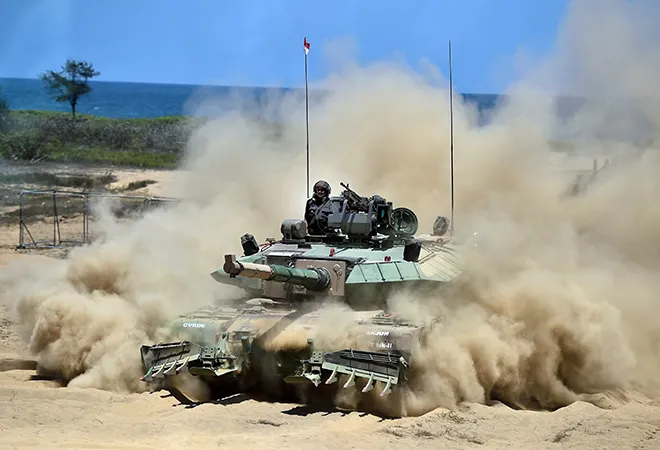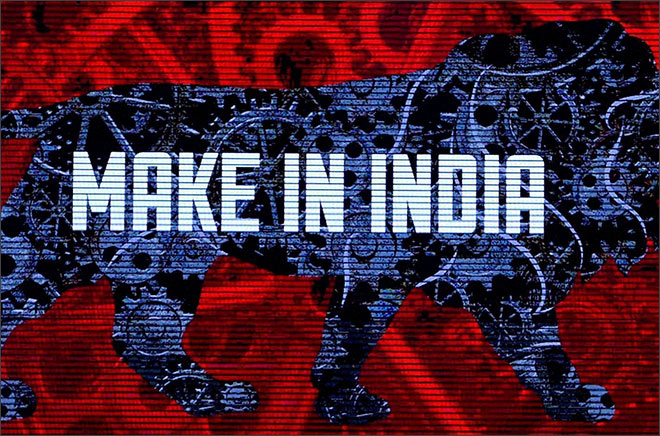
During the recently concluded Defexpo 2018 near Chennai, Prime Minister Narendra Modi re⎯emphasised the urgent need for indigenisation in the manufacture of weapon systems and the government’s commitment to transform India into a defence industry hub. However, he acknowledged the complexity of the task and the slow progress in “Make in India” projects. Defence Minister Nirmala Sitaraman said: “India will not only manufacture for purpose of import substitution but will also boost defence production to export Indian made defence products to other countries.”
The reality, however, is quite different. India despite having the fifth largest defence budget in the world procures 60% of its weapon systems from foreign markets while Pakistan has sold more weapon systems to foreign customers than India. The defence budget for 2018⎯19 has shown just a marginal increase to cater for inflation and the revenue portion of the budget. However, capital expenditure which is of import has shown a downward trend and as the VCOAS Lt. Gen. Sarath Chand stated to the Parliamentary Committee that the amount allotted was just sufficient to meet the committed expenditure, implying that no new weapon system can be procured. This no doubt is alarming, especially the low levels of ammunition held in stock which is insufficient even to fight a 10⎯day war at intense rate.
Despite having the fifth largest defence budget in the world, India procures 60% of its weapon systems from foreign markets.
India’s lumbering bureaucracy and complex procurement procedures are primarily to blame. The Defence Procurement Procedure (DPP) have been enunciated in great detail to cover every contingency and since the turn of the century they have revised at least three times. I have been personally associated with four of the DPPs published in this millennium. Each one no doubt is an improvement on the previous edition. However, the fault lies in the interpretation and implementation. In DPP 2007 a new category of “Make in India” was introduced and was hailed as a panacea of all ills. It was a path breaking move and only two projects were initially selected as test cases for this new venture. The first was “Infantry Combat Vehicle (ICV)” and the second “Battlefield Management Systems (BMS).” The planning and preparation for the ICV was meticulously done and the committee set up by HQ Integrated Defence Staff led by a major general and members from the technical services, scientists and bureaucrats after an extensive survey shortlisted four firms who had the capability to complete this maiden scheme viz. TATA, L&T, Mahindra & OFB. The General Staff Qualitative Requirement was given to them and they were to submit their Detailed Project Reports (DPRs) based on which two firms were to be shortlisted for award of the contract. The Govt. would fund 80% of the development expenditure and the firms were to produce the prototypes for trials by 2014⎯15.
When the DPRs were submitted, the MoD found fault with the evaluation procedure and with pressure being built by the private companies not having been initially shortlisted the entire process was junked in 2012⎯13 after a lapse of four valuable years. When it was reintroduced, 11 firms were given the offer to submit their DPRs. If the evaluation machinery could not handle four firms, it was well nigh impossible to tackle 11 firms.
After a delay of another a couple of years the reality dawned on the authorities and the idea to form conglomerates with a few lead integrators selected and the rest forming part of the sub⎯system manufacturers. Suffice is to say that after a lapse of nine years we are yet to finalise and shortlist the potential two contractors to whom the responsibility to manufacture the prototypes are given. Thereafter time will be required to develop the prototypes (3⎯4 years) trial and evaluation (2 years) and finally concluding the contract (one year) if all goes well and the initial shortlisting is done in 2018, being an optimist we should expect the award of the contract by 2025 and commencement of manufacture in a trickle to begin in 2027! A delay of 18 years!! The only sufferers are the users who will have to operate and maintain the outdated equipment currently held, BMP 2, duly upgraded at an additional cost.
 The defence budget for 2018⎯19 has shown just a marginal increase to cater for inflation and the revenue portion of the budget. | File Photo
The defence budget for 2018⎯19 has shown just a marginal increase to cater for inflation and the revenue portion of the budget. | File Photo
In June 2017, the government appreciating the inherent problems related to procurement of defence equipment evolved the “Strategic Partnership Model” based on the suggestions of the 2015 report submitted by the Dhirendra Singh Committee. By this method, a few private sector firms would be declared as systems integrators based on their proven capability and they would tie up with foreign OEMs with the aim of laying down a strong defence industrial foundation. The firms would make long term investments to develop a base for R&D and production facilities. Initially four segments were chosen, fighter aircrafts, helicopters, submarines and armoured fighting vehicles. This no doubt was another good idea, but the devil is in the execution, some of the areas of concern are:
- Lack of an institutional capacity and capability to take it to its logical conclusion.
- As indicated earlier the “Make” procedure for ICVs failed to achieve the results with just four companies competing for one weapon system. Here all three services are involved with a plethora of weapon systems and the opportunities limitless.
- The decision making bodies need greater autonomy and authority. There is an urgent need of a permanent arbitration committee which can settle disputes expeditiously. In USA, the procurement agency DRAPA has a permanent arbitration committee which resolves such issues amicably and their decision is final.
- There is a lingering fear that the Indian strategic partners having committed their funds to infrastructure and getting the initial order would lose out to the DPSUs in the long run. This would sound the death knell of this well intentioned idea.
Amongst the three services, the Navy has progressed well on the path of indigenisation primarily because of the in⎯house design capability, the Naval Design Bureau. Hence, they do not have to depend on the DRDO for the design & development of the complete ship, but outsource the sub⎯systems for them to develop. In addition, inevitably the ship yards manufacturing the battle ships are headed by a serving naval officer. Therefore, from inception the Navy has full control over all activities.
Amongst the three services, the Navy has progressed well on the path of indigenisation primarily because of the in⎯house design capability, the Naval Design Bureau.
The Army and Air Force are dependent on the DRDO and DPSUs/OFB. A pioneering move was initiated by the Army in 2016 and set up the Army Design Bureau as the nodal agency which acts as a repository of technical knowledge and procedures and assist in formulating operational requirement and General Staff Quality Requirement (GSQR) as also a link between the Army and the private sector. Within a year of its inception, the private sector has responded with 26 solutions to the problems raised by the Army to include development of palm sized drones, drones carrying 50 kg loads and light weight bullet proof jackets. Therefore, the capability exists in abundance but has to be matched with the will and the risk taking ability.
The way forward
To ensure self reliance, the government no doubt is heading in the right direction by laying emphasis on “Make in India”. It is the implementation that needs to be fine tuned and some of the recommendations are:
- Expedite the formation of the Strategic Partnership in the four sectors identified. There would be objections galore against the four fortunate companies which get this privilege, therefore the decision making process must be transparent and the decision taken non negotiable.
- Set up a permanent arbitration cell to whom all objections are addressed and whose decisions are final and not subjected to review.
- The private sector must be allotted big ticket contracts to boost their confidence and morale.
- If the aim is to achieve export capability, then the weapon system must first be in service with our armed forces.
- Bridge a long standing trust gap between the private industry and the Govt. Therefore the Govt. to ensure a level playing field for the private industry, DRDO, DPSUs and OFB.
- In view of India’s strength in software greater emphasis be laid in fields such as AI and cyber security. A concerted effort be made to develop and manufacture the “chip” indigenously.
- To enhance the confidence and authority of DRDO greater financial and administrative autonomy to be given.
- The offset programme has not fructified as envisaged. Hence the restrictions need to be identified and removed and offsets extended to the civil sector too for implementation.
- The staff at the Department of Defence Production need to be trained and given longer tenures to ensure continuity.
Mobilisation on war footing
The defence manufacturing sector needs to be mobilised on a “war footing” and every department, agency or individual connected with the procurement or manufacture has to be held accountable. Electrifying all villages in India seems an easier proposition than achieving self sufficiency in the defence sector. If after all these voluminous instructions the armed forces do not receive the weapon systems they can repose confidence to defend the security of the nation, then the fault lies with every citizen who raises hurdles to ensure we remain dependent on foreign nations for our security and independence.
The views expressed above belong to the author(s). ORF research and analyses now available on Telegram! Click here to access our curated content — blogs, longforms and interviews.




 The defence budget for 2018⎯19 has shown just a marginal increase to cater for inflation and the revenue portion of the budget. | File Photo
The defence budget for 2018⎯19 has shown just a marginal increase to cater for inflation and the revenue portion of the budget. | File Photo PREV
PREV


